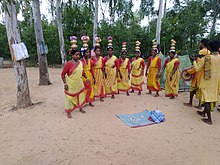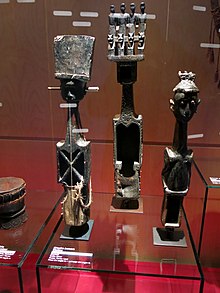Santal people
[7] Santals are the largest tribe in the Jharkhand and West Bengal in terms of population and are also found in the states of Odisha, Bihar, Assam and Tripura.[B] According to linguist Paul Sidwell, Austro-Asiatic language speakers probably arrived on coast of Odisha from Indochina about 4,000–3,500 years ago (c. 2000 – c. 1500 BCE).[12] From there, they claim, they were pushed onto Chhota Nagpur Plateau, then to Jhalda, Patkum and finally Saont, where they settled for good.Colonial scholar Colonel Dalton claimed in Chai there was a fort formerly occupied by a Santal raja who was forced to flee when the Delhi Sultanate invaded the territory.Santal from Cuttack, Dhalbhum, Birbhum, Manbhum, Hazaribagh migrated and started cultivating these lands as peasants [15][E] sponsored by landowners and the British who were desperate for labour.[15][16][17][F] Under British direction, Santals took loans from non-Santal moneylenders to buy iron tools, seed grain and oxen as individuals and families, rather than groups as was their custom for working the land.Mahajans from Bengal and Baniyas from Bihar began selling goods from elsewhere, and many Santals, seeing them as exotic, were tricked into debt to buy them, usually with a mortgage on their land.30,000 Santals, led by Sidhu and Kanhu Murmu, attacked the zamindars and other outsiders (dikkus) who had made their lives so miserable, as well as the British authorities.Administration of the community was primarily made the responsibility of the village headman, or pradhan, who was also given the power to collect taxes.Newly established Christian missions brought education, and many Santals moved to the tea plantations in Assam, North Bengal, where they still remain today.Santals stopped paying rent to the zamindars, beat up revenue inspectors, and led agitations against the moneylenders.After the Pakistani military crushed the uprising and burned many Santal homes, many fled across the border to Malda in India.[20] In northern West Bengal, tribal peasants participated in Naxalbari uprising led by a Santal communist leader Jangal Santhal.[18] These Santals have also agitated for recognition of their traditions in the census as a separate religion, sarna dharam, for which Jharkhand assembly passed a resolution in 2020.The most important marker of a person when interacting with others in Santal society is their standing as marang ("senior") or hudin ("junior").This standing is evaluated by relation: for example, is someone is greeting their father's elder brother's son, they would be the junior irrespective of age.[U] The junior clans are Baskey or Baske (stale rice), Besra (falcon), Chorey or Chonre (lizard), Pauria or Pawria (pigeon) and Bediya.In addition, Besras are sometimes treated differently due to their perceived low status, but other than the context of marriage, they play no role in social life.The khunti is identified by some distinguishing feature of the ancestor, such as poeta, people who wear a thread on their chest in worship.The bride arriving first carrying a pot with white clay, the symbol of a woman returning to her natal village as a guest.[Y] Religion among Santal people of Bihar, West Bengal, Jharkhand, Odisha and Tripura[24][25] The Santal are granted Scheduled Tribe status in five states: Bihar, West Bengal, Jharkhand, Odisha, and Tripura, where they account for a total population of 6,570,807 according to the 2011 Census of India.They regarded it as having more political motives than religious and developed their own religion, named Sari Dharam, based on their ancestral ethics, values, and beliefs.However, while all those terms differ in nomenclature from a religio-political perspective, in practice, they reflect a synthesis of ancestral autonomous beliefs and elements of dominant religions like Hinduism and Christianity.In the religious beliefs of Santals, the core of reverence falls on a court of spirits (bonga), who handle different aspects of the world and who are placated with prayers and offerings.[AD] However bonga in itself simply means a supernatural force in the world and has no specific connotation with good or evil.[28] The Santal creation story holds that originally the world was water, and Marang Buru and some lesser deities were the only inhabitants.Another version tells how Pilchu Budhi was in fact in tears at her daughters' disappearance, but Marang Buru reassured her that they were all safe and brought her to reconcile with her husband.When their sons found out they had married their sisters, they were very angry and would have killed their parents if Marang Buru had not hidden them in a cave, where they stayed for the rest of their days.[26] As in Santal religion, religious specialists are drawn from the village or family and serve a wide range of spiritual functions that focus on placating potentially dangerous spirits and co-ordinating rituals.They also perform animal sacrifices to honor their gods and accept flesh, including beef and pork, practices that are generally prohibited in Hinduism.









Naga woman
Baha parabBangladeshJharkhandWest BengalOdishaTripuraSantaliHinduismSari DharamSarna DharamChristianityMundasJuangsKhariasSavarasKorkusBhumijsAustroasiaticIndian subcontinentRajshahi DivisionRangpur DivisionMunda languagesAustroasiatic languageMedinaporePaul SidwellAustro-Asiatic languageIndochinaHazaribagh districtChhota Nagpur PlateauJhaldaPatkumHazaribaghDaltonDelhi SultanateBritish IndiaBengal Famine of 1770Jungle MahalsEast India CompanyPermanent SettlementDamin-i-kohCuttackDhalbhumBirbhumManbhumSantal ParganaMal PahariasexploitedzamindarsMahajansBaniyasmortgagemoneylenderslandlessBrahminicalexploitationcorruptSantal rebellionSidhu and Kanhu MurmuBritish troopsIndian Rebellion of 1857Republic of IndiaSantal ParganasBritish CrownNorth BengalScheduled TribesTebhaga movementNaxalbari uprisingJangal SanthalGuevaristNaxaliteinsurgencyRed CorridortribalKarmakarMahaliegalitariancaste HindutotemisticHansdaNilgaiMarandiIschaemum rugosumPleiadesHembrambetel palmfalconSohraiDashainPurulia districtDinajpur districtLungi Panchi DanceChadar Badarpuppetryvillage councilgeometric patternsBhubaneswarbride pricemarriage contractSarnaism2011 Census of IndiaChristianMuslimBuddhistAtheistTribal religiondoctrineautonomous religious beliefsbeginning of census operations in Indiareligious-political movementsAdibasiAnimismspiritsMarang Burumonotheisticpriestmedicine-mansacred groveMayurbhanj districttribesChota NagpurKhariaTea-garden community of AssamFifth Schedule areasSixth Schedule areasBritish RajOther Backward Class